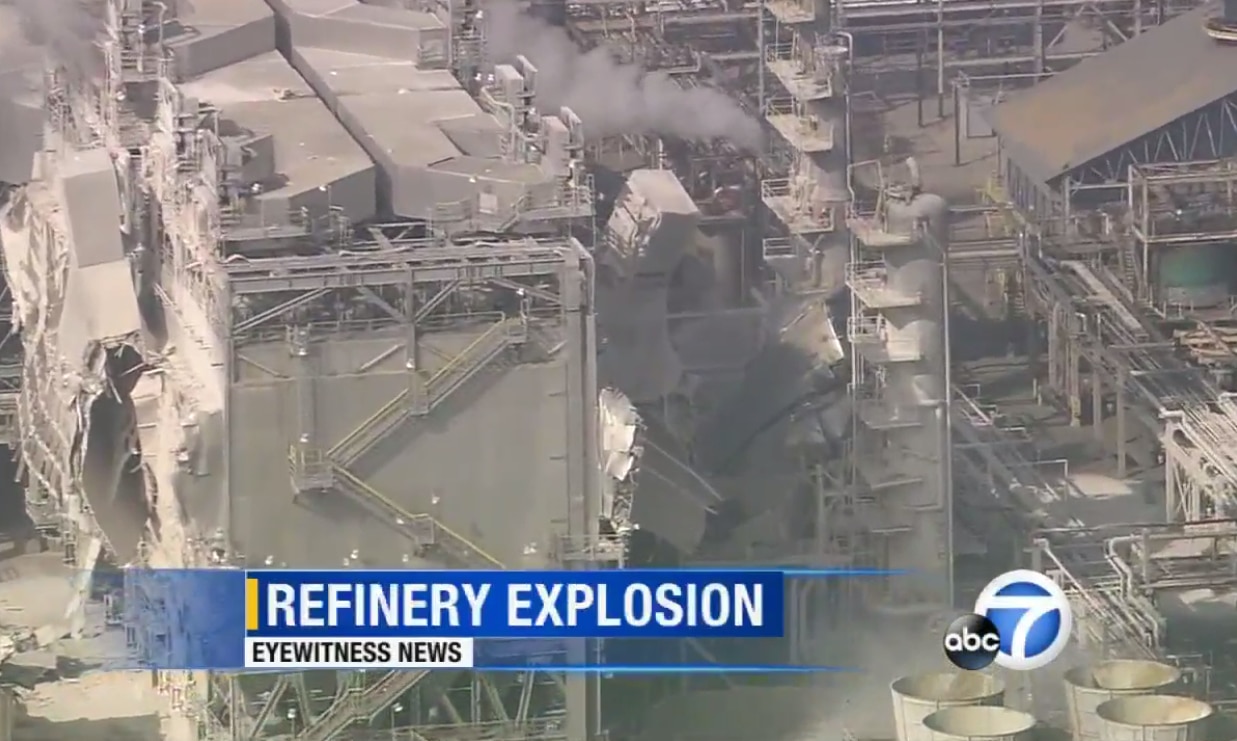On the morning of February 18, 2015, the ExxonMobil oil refinery in Torrance, California exploded, causing chemical ash to rain on the surrounding community for hours. Eight workers had to be decontaminated and four were sent to hospitals with minor injuries.
California Division of Occupational Safety and Health (Cal/OSHA) ordered ExxonMobil to shut down the unit until it could demonstrate safe operation.
In August, Cal/OSHA issued 19 citations for workplace safety and health violations at the Torrance refinery. The company was fined $566,600 in penalties in connection with the blast.
The explosion resulted in the costliest disruption at a California refinery in the past 16 years, with motorists paying at least $2.4 billion in higher pump prices in the following six months.
After spending around $162 million to repair the damaged equipment and upgrade the other equipment, it was given the green light to restart operations from the South Coast Air Quality Management District (AQMD) in April.
With new evidence that the explosion could have been much worse, and that other aging refineries around the country are also at risk, scientists, industry watchdogs and a few lawmakers are sounding an alarm.
What Went Wrong at Torrance?
The sequence of events leading to the explosion started six days earlier in what’s known as a Fluid Catalytic Cracking (FCC) Unit, which converts low-value, thick oil into gasoline by “cracking” large molecules into smaller molecules. On February 12, problems with a piece of equipment called an expander caused the refinery’s FCC unit to go into idle, also known as “safe park” mode.
With the FCC unit shut down, steam was forced into a reactor for six days. This was to prevent hydrocarbons from flowing back from the main distillation column. On the morning of the accident, steam escaping through an open flange on the expander was traveling through a leaking slide valve connected to the reactor.
Operators couldn’t continue maintenance work with leaking steam. An outside supervisor reduced the amount of steam being forced into the reactor so maintenance could continue. But at the time nobody knew that hydrocarbons were leaking into the main distillation column from interconnected equipment. As the pressure of the steam dropped, the hydrocarbons flowed back into the reactor, out through the leaking slide valve and eventually into the electrostatic precipitator (ESP), a filtration device that removes particulates. In the ESP the hydrocarbons found an ignition source and exploded.
The blast sent a piece of equipment weighing 80,000 pounds flying nearly 100 feet. It and large pieces of debris hit scaffolding surrounding a tank containing a form of hydrofluoric acid. If the equipment had hit the tank it have caused a catastrophic release of the chemical into the surrounding neighborhood, according to the U.S. Chemical Safety Board (CSB), the independent agency in charge of investigating serious chemical accidents.
The February 2015 explosion wasn’t the first accident at the ExxonMobil refinery and the agency and residents near the Torrance refinery worry that if another blast occurs – and there is no guarantee it won’t – their luck could run out.
Why it Could Happen Again
Soon after the blast, U.S. Representatives Ted Lieu and Maxine Waters, who serve south L.A. county districts, successfully petitioned the CSB to launch a federal investigation on safety conditions in the refinery.
In January the CSB announced preliminary findings of the root causes of the blast and found several safety deficiencies that contributed to the disaster. Among them:
- Management failed to review an outdated procedure and inadequate hazard analyses.
- Machinery that contributed to the blast had operated since 2010 without a maintenance overhaul.
- Critical pieces of equipment were in use beyond their “safe operating life.”
At the January public hearing, CSB Investigator-in-charge Mark Wingard said ExxonMobil implemented no effective safeguards to mitigate the threat of a combustible mixture igniting in the electrostatic precipitator.
“Had flying debris ruptured the tank of modified [hydroflouric acid], this accident could have been far worse,” CSB Chairwoman Vanessa Allen Sutherland said in a statement.
Sutherland added hydrofluoric acid (HF) can pose a severe hazard to people and environment if a release occurs.
He said: “After HF acid vaporizes, it condenses into small droplets that form a dense, low-lying cloud that will travel along the ground for several miles, and can cause severe damage to the respiratory system, skin and bones of those who are exposed, potentially resulting in death.”
There are 333,000 residents, 71 schools and eight hospitals within a three-mile radius of the Torrance refinery, CSB said.
Cal OSHA told Associated Press that management knew the leak posed a hazard but didn’t correct the problem and had there had been problems with the FCC unit for as long as nine years.
ExxonMobil is refuting the agency’s findings that negligence caused the blast.
The CSB says the investigation is ongoing because it’s still waiting for more information from ExxonMobil. Investigators are on the record saying they faced “a lack of cooperation” from ExxonMobil to comply with requests for information about the near miss and gave “no or incomplete responses” to dozens of its subpoena requests
The agency is asking the Department of Justice to intervene in an effort to compel the company to respond. But Sutherland in January said that ExxonMobil asserted that the CSB lacks jurisdiction to even investigate what the agency calls a “near miss.”
CSB investigators say the series of failures leading to the ExxonMobil Torrance refinery blast are similar to the causes of the August 6, 2012, fire at the Chevron Refinery in Richmond, California, a fire that sent more than 15,000 residents to hospital.
In a final report on Richmond, the CSB proposed recommendations for substantial changes to the way refineries are regulated in California. The agency also added process safety management reform to its list of most wanted safety improvements.
A series of state regulations and safety standards on refineries in California have been in development since the Chevron Richmond fire. California lawmakers used the CSB recommendations to revise and strengthen its refinery safety requirements to address numerous issues raised in the CSB’s Chevron report. Chairperson Sutherland said: “The actions being taken in the state are some of the most substantive safety improvements happening in the United States right now.”
These new rules are now with the California Office of Administrative Law — the last step before implementation.
New Regulations Could Spare Economy
Research group RAND released a cost-benefit analysis of new regulations in March 2016. The 125-page report concluded that stricter regulations are a cost-effective method to increase safety at the state’s dozen refineries.
“The new process safety management regulations could improve safety at California refineries, which would, in turn, result in fewer major process incidents and fewer releases of hazardous materials from refineries,” the report said.
The report found the cost of the refinery’s 15-month outage robbed the California economy of more than $14 billion. By contrast, the price tag on new regulations cost an average of $220 million, according to the report.
Also in the RAND report is a damning account of the condition of facilities in California.
Jamie Court, President of Consumer Watchdog, told DeSmog: “The study is a good skim for anyone who wants to understand the major refinery disasters of the last decade, the significant costs of an outage in California, and how run-down these aging oil machines are,”
Even with those state regulations, Court says, there is no guarantee another disaster won’t happen in California.
“The regulations will make it a little safer by making sure equipment is regularly maintained, but it won’t get rid of the hydrofluoric acid. And they won’t call for upgrading facilities that are nearing 100 years old. Parts aren’t replaced. These plants are held together with duct tape. That’s why there are so many outages.”
Moure-Eraso tells DeSmog that if the regulations that the CSB recommended had been in place after the Chevron fire and explosion in 2012, the 2015 Torrance blast probably wouldn’t have happened.
But he adds while California is at the cutting edge of regulation now, people living near refineries still aren’t safe. And in states were regulation is more lax?
“The age of these refineries nationwide is an issue, and they are functioning under last century’s standards,” Moure-Eraso says.
Moure-Eraso has also championed tougher regulations at the federal level and says the U.S. should have standards more like those in Europe, but he admits that the strength of the industry lobby and a lack of political will means that’s unlikely to happen.
“California has a more responsive political system than at the federal level,” he says. “And as far as regulations, the Chemical Safety Board doesn’t have the right to compel, just to give recommendations.”
A “Bhopal Waiting to Happen”
HF is used at only two California refineries — in Torrance, and at the Valero Wilmington refinery, also near Torrance — and is used as a catalyst to create a high-octane gasoline additive.
The HF is supposedly modified with an additive to make it safer, but Congressman Lieu has said CSB officials have expressed concerns to him about its efficacy.
At the refinery, the additive as well as temperature and pressure controls are supposed to render 40 percent of any acid spill inert, Wingard said. In theory the HF vapor would form a liquid that would be more easily contained than a gas.
But Lieu said ExxonMobil doesn’t have proof that the additive works. “There has been no non-industry-sponsored tests that show MHF would drop to the ground,” Lieu told south bay newspaper The Daily Breeze in January.
Jamie Court tells DeSmog that California’s refineries are “death traps located in the densest urban areas of the state and capable of replicating a Bhopal-like disaster.”
Sally Hayati, PhD, the leader of the Torrance Refinery Action Alliance, one of the grassroots groups that formed in the wake of the 2015 explosion, says the CSB should study the claims that an additive to the hydrofluoric acid would make it easier to contain.
She points to reports of chemical industry experts who have said the amount of additive needed to reduce the size of the vapor cloud, if released into the atmosphere, is much higher than ExxonMobil is claiming.
“There are little HF leaks every year from refineries around the country, including at Torrance, and nobody’s looking at that danger,” she says.
“The industry is saying there hasn’t been a massive disaster involving HF yet. But that’s like saying ‘I’m a good risk as a driver even though I’ve been in dozens of collisions. But hey at least I haven’t killed anyone.’”
Hayati, who conducted a detailed review of Exxon’s Offsite Consequence Analysis, says she wants, at the very least, a study to look at safe alternatives, not just additives, to HF.
“They say the reason the explosion happened was steam pressure used to keep hydrocarbons out. But they’re still using the same method and won’t replace it or change it.”
In an election year, one would think these issues would take center stage. Yet, Hayati and other activists say not one city council member in Torrance or Los Angeles – or the mayors of those cities – will touch the issue.
HF isn’t used in every refinery nationwide, but there are significant dangers with facilities that do use it, as outlined in a 2011 report by the Center for Public Integrity and ABC News.
The report found that at least 16 million Americans live in the potential path of HF if it were to be released in an accident or a terrorist attack.
Millions at Risk
A new report, “Living in the Shadow of Danger,” from the Center for Effective Government (CEG) evaluated 12,000 refineries across the U.S.
The CEG included a graded scorecard. More than half of U.S. states were given a “D” (poor grade). Massachusetts and Wisconsin were awarded an “F” — a failing grade.
The report also found that 23 million people, including 4.9 million children, were living within one mile of a refinery. There were also 12,000 schools inside that one mile radius, according to the report.
The fact that so many people live near these facilities speaks to the age of the refineries. The Torrance refinery went online in the midst of the Great Depression, in 1929. The sprawl of suburban Los Angeles simply grew around it.
According to Moure-Eraso, the reason few refineries make necessary changes voluntarily is, not surprisingly, money.
He says: “Changes are always made ex-post facto, after an accident, and everyone knows that accidents are very costly. But they know it takes a lot of investment to make changes to prevent disasters. The way to look good if you’re in charge of these plants to do things that improve the bottom line, not make big investments. The manager of a refinery knows he will be there only for a few years. If nothing bad happens on his watch and he increases revenue, he will be promoted.”
Moure-Eraso adds this culture applies even if that manager is rolling the dice with people’s lives.
It’s not clear that ExxonMobil suffered financially from the blast, because it won’t say. The company’s annual profit in 2016 was half of what it made in 2015, but experts say that was mainly due to the global oil glut. But the company still reported 2015 earnings of $16.2 billion.
Ultimately the refinery will be under new management soon. ExxonMobil is completing the sale of the Torrance plant to the Texas-based oil company PBF Energy.
Main image: Still of ABC7 Eyewitness News coverage of the ExxonMobil Torrance oil refinery blast
Subscribe to our newsletter
Stay up to date with DeSmog news and alerts







